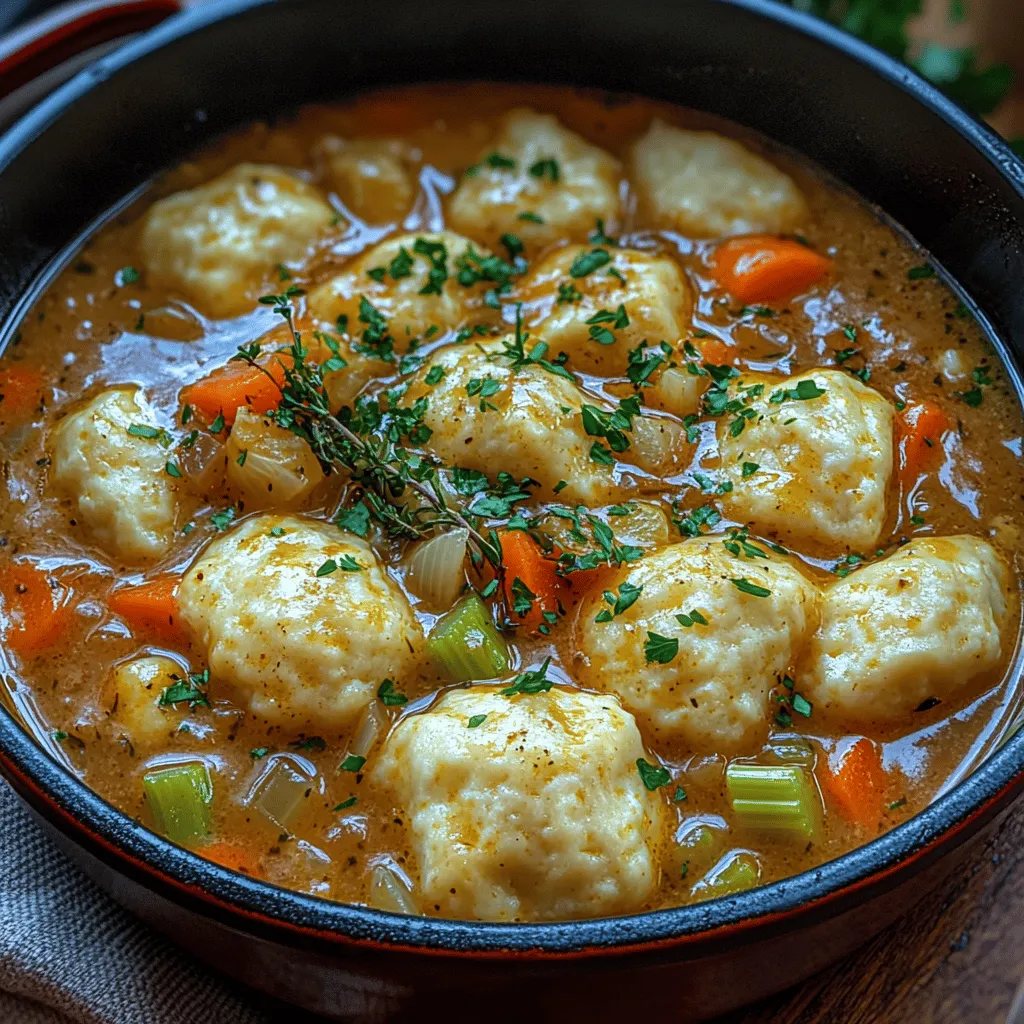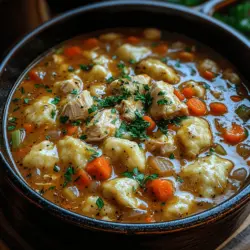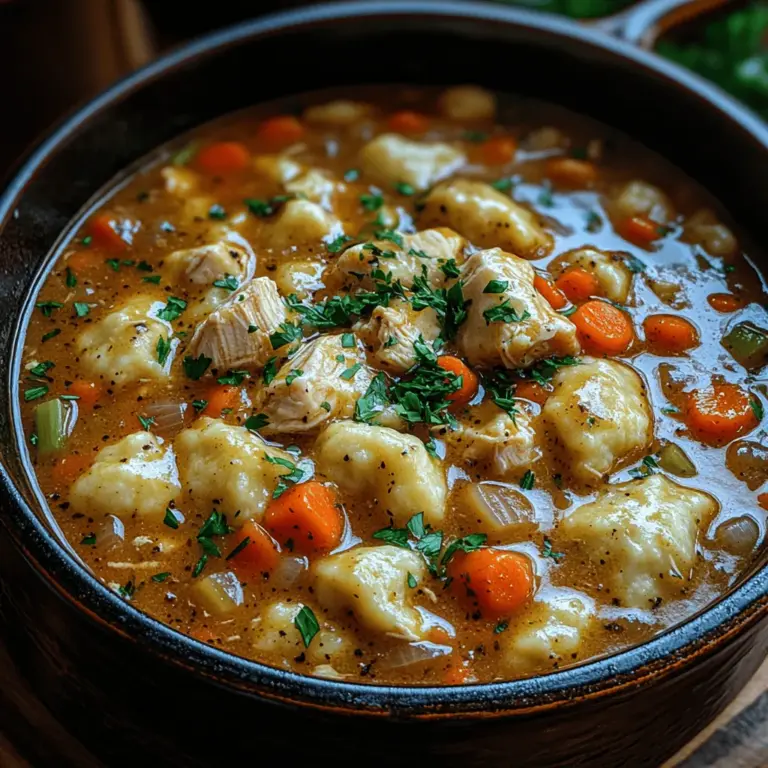Introduction
There’s nothing quite like the warmth and comfort of a hearty bowl of chicken and dumplings on a chilly evening. This classic dish has been a beloved staple in many households, offering a delightful combination of tender chicken, fluffy dumplings, and savory broth that creates a soothing and satisfying experience. As the aroma fills your kitchen, it evokes memories of family gatherings and cozy nights spent around the dinner table.
In today’s fast-paced world, the significance of homemade meals has never been more pronounced. Preparing dishes from scratch allows us to nurture not just our hunger, but also our connections with loved ones. Chicken and dumplings serve as a perfect example of a dish that brings people together; each bite is not only a taste of comfort but also a reminder of the care and effort that goes into cooking for those we cherish.
In this article, we’ll guide you through a simple yet delicious recipe for cozy chicken and dumplings that you can easily prepare in your own kitchen. With a few quality ingredients and some straightforward techniques, you’ll create a meal that warms both the body and soul.
Understanding the Ingredients
To create the perfect chicken and dumplings, it’s essential to understand the role of each ingredient in the dish. The main components include chicken, vegetables, spices, and of course, the dumplings themselves. Let’s take a closer look at each element.
Chicken: The Heart of the Dish
The chicken is undoubtedly the star of this dish, so selecting quality meat is crucial for both flavor and nutrition. Opt for bone-in, skin-on chicken thighs or breasts for the best results. The bones add depth to the broth, while the skin contributes richness. If you prefer a leaner option, skinless chicken works too, although it may not provide the same level of flavor.
Vegetables: Freshness Matters
The vegetables you choose can significantly impact the overall taste of your chicken and dumplings. Classic options include carrots, celery, and onions, but don’t hesitate to incorporate seasonal produce for added nutrients and flavor. Fresh vegetables not only enhance the dish’s taste but also contribute to its nutritional value, making your meal healthier and more satisfying. For example, adding peas or bell peppers can introduce a touch of sweetness and color.
Spices and Herbs: Elevating the Flavor Profile
Herbs and spices play a pivotal role in developing the rich flavor profile of the stew. Thyme and rosemary are traditional choices that complement the chicken beautifully. Thyme adds an earthy note, while rosemary imparts a fragrant aroma that elevates the entire dish. Feel free to experiment with other herbs like parsley or sage to create your unique blend. A pinch of black pepper and a dash of salt will also go a long way in enhancing the taste.
Optional Ingredients: Adding a Touch of Luxury
For those looking to elevate their chicken and dumplings, consider incorporating heavy cream into the stew. This addition creates a luxuriously creamy texture that enriches the broth and makes every bite feel indulgent. While it’s not necessary for a delicious outcome, it can certainly take your dish to the next level, especially for special occasions or family gatherings.
Preparation Steps for the Chicken Stew
Now that we’ve covered the ingredients, it’s time to dive into the preparation of the chicken stew. The following steps will guide you through the process, ensuring that each component comes together seamlessly.
Sautéing the Vegetables
Start by preparing your vegetables. Chop the onions, carrots, and celery into small, even pieces. This uniformity is essential to ensure they cook evenly. In a large heavy-bottomed pot or Dutch oven, heat a tablespoon of oil over medium heat. Once the oil is hot, add the chopped onions, carrots, and celery.
Sauté the vegetables for about 5 to 7 minutes, stirring occasionally, until they begin to soften and the onions become translucent. This step is vital for building a flavorful base for your stew, as the natural sugars released during cooking will caramelize and enhance the overall taste.
Browning the Chicken
While the vegetables are sautéing, prepare the chicken. Pat the pieces dry with paper towels to ensure they brown nicely. Season the chicken generously with salt and pepper. Once the vegetables are softened, push them to the sides of the pot and add the chicken pieces in a single layer, skin side down.
Allow the chicken to brown for about 5 minutes without moving it. This browning process is crucial; it adds depth and richness to your stew through the Maillard reaction, which occurs when proteins are exposed to high heat. After 5 minutes, flip the chicken to brown the other side for an additional 5 minutes.
Simmering the Stew
Once the chicken is browned, you can begin to build the stew. Add garlic, thyme, and rosemary to the pot, stirring to combine. Cook for an additional minute until fragrant. Then, pour in enough chicken broth to cover the chicken and vegetables completely. Bring the mixture to a gentle simmer, scraping the bottom of the pot to release any flavorful bits stuck to the bottom.
Reduce the heat to low, cover the pot, and allow the stew to simmer for about 30-40 minutes. This simmering time is essential for the flavors to meld and develop. If you prefer a thicker stew, you can let it simmer uncovered for the last 10 minutes. For a creamier texture, consider stirring in a splash of heavy cream during the last few minutes of cooking.
Adjusting for Personal Preferences
During the simmering process, taste the stew and adjust the seasoning as necessary. You might want to add more salt, pepper, or herbs to suit your palate. If you enjoy a bit of heat, consider adding red pepper flakes or a splash of hot sauce. This dish is incredibly versatile, allowing you to customize it according to your preferences.
Crafting the Perfect Dumplings
With the chicken stew simmering away, it’s time to turn our attention to the dumplings. These fluffy morsels are the perfect complement to the rich broth and tender chicken. Here’s how to make them.
Ingredients Breakdown for Dumpling Preparation
To create the perfect dumpling, you’ll need the following ingredients:
– All-purpose flour: Provides structure and texture to the dumplings.
– Baking powder: A leavening agent that helps the dumplings rise and become fluffy.
– Salt: Enhances the flavor of the dumplings.
– Milk: Adds moisture and richness to the dough.
– Butter: Contributes flavor and tenderness.
Mixing the Dumpling Dough
In a mixing bowl, combine 2 cups of all-purpose flour, 2 teaspoons of baking powder, and 1 teaspoon of salt. Whisk the dry ingredients together to evenly distribute the baking powder. Next, pour in ¾ cup of milk and ¼ cup of melted butter. Using a spatula or wooden spoon, mix until just combined. The dough should be slightly sticky but manageable.
Avoid overmixing; you want the dumplings to remain light and tender. If the dough feels too dry, add an additional splash of milk. Once your dumpling dough is ready, you can set it aside while the stew finishes simmering.
As the chicken and vegetables meld into a fragrant broth, and the dumpling dough comes together, you are just moments away from creating a warm, cozy meal that will bring joy to your table.
In the next section, we will guide you through the final steps of adding the dumplings to the stew and cooking them to perfection, ensuring that this comforting dish is ready for you and your loved ones to enjoy.

Importance of Not Overmixing to Maintain Fluffy Dumplings
When preparing dumplings for your cozy chicken and dumplings, achieving the perfect texture is crucial. One of the most common pitfalls is overmixing the dough. To maintain fluffy, tender dumplings, mix your ingredients just until they are combined. Overmixing develops gluten in the flour, leading to dense and chewy dumplings instead of the light, fluffy texture we all desire.
If you’re using a stand mixer, only mix on low speed and stop as soon as the dough comes together. If you’re mixing by hand, use a gentle folding motion rather than vigorous stirring. This careful approach will ensure that your dumplings rise beautifully when added to the stew and create that comforting experience we expect from this dish.
Alternative Flour Options for Different Dietary Needs
For those with dietary restrictions, there are several alternative flour options that you can utilize to create dumplings without sacrificing flavor or texture.
1. Gluten-Free Flour: A gluten-free all-purpose flour blend can often be substituted in equal amounts for regular flour. Look for brands that contain xanthan gum or add it separately to help mimic the texture of traditional dumpling dough.
2. Almond Flour: Using almond flour can provide a nutty flavor and a different texture. However, you may need to adjust the liquid in your recipe, as almond flour absorbs moisture differently than wheat flour.
3. Oat Flour: Ground oats can also serve as a gluten-free option. When using oat flour, consider combining it with a binding agent like psyllium husk or chia seeds for better structure.
4. Spelt Flour: If you’re looking for a whole grain alternative but still want some gluten, spelt flour is a great option. It provides a slightly nuttier flavor and can be used in the same quantities as all-purpose flour.
Experimenting with different flours can lead to delightful variations in your dumplings, allowing everyone to enjoy this comforting dish regardless of dietary needs.
Incorporating Dumplings into the Stew
Now that you have your dumpling dough ready, it’s time to incorporate it into your simmering chicken stew. Here’s how to do it step by step:
1. Prepare the Stew Base: Ensure that your chicken and vegetable stew is simmering gently on the stove. The broth should be bubbling softly, indicating that the flavors are melding together nicely.
2. Form the Dumplings: Using a spoon or cookie scoop, drop spoonfuls of the dumpling dough directly onto the surface of the simmering stew. Leave space between each dumpling, as they will expand while cooking.
3. Cover the Pot: This is a crucial step—cover the pot with a lid immediately after adding the dumplings. Covering helps trap steam, which is essential for the dumplings to cook through and rise properly.
4. Cook Without Peeking: Let the dumplings cook for about 10-15 minutes without lifting the lid. Peeking can release steam and disrupt the cooking process.
5. Check for Doneness: You can check if the dumplings are done by inserting a toothpick into one. It should come out clean, and the dumplings should be puffed up and have a light, airy texture.
6. Tips for Ensuring Dumplings are Light and Fluffy: If you want to ensure the best results, avoid double-checking too soon. The dumplings should have a slight bounce when touched. If they feel dense, they may need more time to cook.
Final Touches and Serving Suggestions
Once your dumplings are cooked, it’s time to add the final touches before serving your cozy chicken and dumplings:
1. Check for Seasoning: Give the stew a taste test before serving. You might want to adjust the seasoning with additional salt and pepper, or even a splash of lemon juice for brightness.
2. Presentation Ideas: For an appealing presentation, ladle the chicken and dumplings into shallow bowls. This allows the hearty stew to shine and makes it easy for guests to enjoy.
3. Garnishing with Fresh Herbs: Sprinkle freshly chopped parsley or thyme over the top just before serving. The vibrant green color adds freshness and a hint of flavor that complements the dish beautifully.
4. Ideal Side Dishes: While chicken and dumplings are filling on their own, consider serving a simple side salad or steamed green beans for a pop of color and added nutrients. A crusty piece of bread is also perfect for soaking up the delicious broth.
Cultural Significance and Variations of Chicken and Dumplings
Chicken and dumplings is not just a meal; it’s a comforting symbol of home and warmth in many cultures. Historically, this dish has roots in various culinary traditions, making it a beloved comfort food across the globe.
1. Historical Context: The origins of chicken and dumplings can be traced back to early American settlers who relied on simple ingredients that were readily available. The dish became a staple in the South, evolving into various regional interpretations over time.
2. Regional Variations: In the United States, you’ll find numerous adaptations. For instance, in the South, some recipes feature a richer, creamier broth, while in the Midwest, you might find a more broth-heavy version with thicker dumplings. In Asian cultures, similar concepts exist, such as chicken and wontons or dumplings served in brothy soups.
3. Cultural Adaptations: Each culture infuses its unique ingredients and cooking styles into the dish. For example, in Italy, you might find chicken and dumplings served with gnocchi, while in India, spices and herbs can transform the stew into a fragrant curry dish.
4. Creative Twists: Feel free to experiment with non-traditional proteins like turkey or even plant-based options for a vegetarian or vegan version. Adding seasonal vegetables like carrots or peas can also provide a colorful and nutritious boost to the dish.
Nutrition and Health Benefits
Chicken and dumplings is more than just a comfort food; it can also be a nourishing choice.
1. Nutritional Benefits: The chicken provides a good source of protein, while the vegetables offer essential vitamins and minerals. The dumplings, made with flour, contribute carbohydrates, giving you energy for the day.
2. Healthier Adjustments: If you’re looking to make this dish healthier, consider using lean chicken breast instead of thighs, opting for low-fat milk or broth, and reducing the amount of butter in the dumplings. You can also sneak in more vegetables to boost the nutrient content.
3. Balanced Meals: Comfort food can absolutely fit into a healthy diet. By incorporating plenty of veggies and lean proteins, you create a well-rounded meal that satisfies both your cravings and nutritional needs.
Conclusion
There’s something undeniably heartwarming about a pot of chicken and dumplings simmering on the stove. This dish evokes feelings of comfort, nostalgia, and warmth, making it a perfect choice for family gatherings or cozy nights in.
By trying your hand at this recipe, you’ll not only enjoy the delicious flavors but also create a fulfilling cooking experience that can bring your loved ones together. The lasting appeal of chicken and dumplings lies in its ability to provide nourishment for the body and soul, making it a cherished staple in many households. So gather your ingredients, roll up your sleeves, and dive into a cooking adventure that promises to warm your heart and home.


